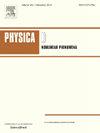基于记忆的弥漫性细菌感染模型的Hopf-Hopf分岔
IF 2.7
3区 数学
Q1 MATHEMATICS, APPLIED
引用次数: 0
摘要
细菌感染挑战免疫系统,引起炎症,白细胞在识别和对抗有害细菌方面发挥重要作用。这些白细胞通过趋化作用到达感染部位,趋化作用是由细菌的化学信号引导的。然后,白细胞要么吞噬并消灭有害细菌,要么释放酶来中和感染。这一现象对于控制感染和防止其传播至关重要。然而,这一过程受到记忆效应的影响,这导致他们的运动受到先前信号的影响,以及反应延迟。这些变量使免疫反应复杂化,因此了解它们对感染动力学和炎症的影响对于开发更好的治疗方法至关重要。在本文中,我们分析了一个具有空间记忆效应的弥漫性细菌感染模型,考虑了延迟对白细胞运动的影响。通过稳定性和分岔分析,得到了Hopf分岔和稳定性切换的充要条件。结果表明,在没有时滞的情况下,系统在一定条件下保持稳定。然而,在存在时间延迟的情况下,当时间延迟超过临界阈值时,系统将发生Hopf分岔,并且平衡点的稳定性受到存储延迟的影响,导致非均匀的空间周期振荡。此外,我们还探讨了Hopf-Hopf分岔的发生和稳定性开关。在范式理论和中心流形定理的基础上,进一步详细研究了诱导Hopf-Hopf分岔。最后,给出了数值模拟来验证我们的理论发现。本文章由计算机程序翻译,如有差异,请以英文原文为准。
Hopf–Hopf bifurcation of the memory-based diffusive bacterial infection model
Bacterial infections challenge the immune system, causing inflammation in which leukocytes play an important role in identifying and combating harmful bacteria. These white blood cells, leukocytes, navigate to infection sites by chemotaxis, which is guided by chemical cues from bacteria. The leukocytes then either engulf and destroy the harmful bacteria or release enzymes to neutralize the infection. This phenomenon is crucial for controlling infections and preventing their spread. However, this process is influenced by memory effects, which cause their movement to be affected by previous signals, as well as reaction delays. These variables complicate immune responses, thus understanding their impact on infection dynamics and inflammation is critical for developing better treatments. In this paper, we analyze a diffusive bacterial infection model with a spatial memory effect, taking into account the impact of delay on the movement of leukocytes. Through stability and bifurcation analysis, we obtain the sufficient and necessary conditions for the Hopf bifurcation and stability switches. It is found that in the absence of delay the system remains stable under certain conditions. However, in the presence of time delay, the system will undergo the Hopf bifurcation, when the time delay exceeds a critical threshold, and the stability of the equilibrium point is affected by the memory delay, leading to inhomogeneous spatially periodic oscillations. Moreover, we explore the occurrence of Hopf–Hopf bifurcation and the stability switches. The induced Hopf–Hopf bifurcation is further studied in detail based on normal form theory and the center manifold theorem. Finally, numerical simulations are provided to validate our theoretical findings.
求助全文
通过发布文献求助,成功后即可免费获取论文全文。
去求助
来源期刊

Physica D: Nonlinear Phenomena
物理-物理:数学物理
CiteScore
7.30
自引率
7.50%
发文量
213
审稿时长
65 days
期刊介绍:
Physica D (Nonlinear Phenomena) publishes research and review articles reporting on experimental and theoretical works, techniques and ideas that advance the understanding of nonlinear phenomena. Topics encompass wave motion in physical, chemical and biological systems; physical or biological phenomena governed by nonlinear field equations, including hydrodynamics and turbulence; pattern formation and cooperative phenomena; instability, bifurcations, chaos, and space-time disorder; integrable/Hamiltonian systems; asymptotic analysis and, more generally, mathematical methods for nonlinear systems.
 求助内容:
求助内容: 应助结果提醒方式:
应助结果提醒方式:


